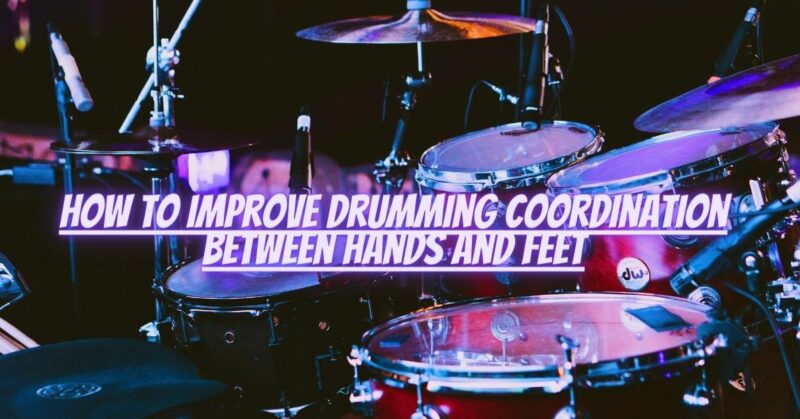Drumming coordination is a vital aspect of becoming a skilled drummer. The ability to synchronize your hands and feet seamlessly is essential for creating intricate rhythms, executing complex patterns, and maintaining a solid groove. Whether you’re a beginner seeking to improve your coordination or an experienced drummer looking to refine your skills, this article will provide you with valuable tips on how to enhance your drumming coordination between your hands and feet.
- Start with Basic Exercises: Begin by practicing simple exercises that isolate specific combinations of hand and foot movements. Start with exercises such as playing quarter notes on the bass drum while keeping a steady eighth-note pulse on the hi-hat or snare drum. Gradually increase the complexity of these exercises as your coordination improves.
- Utilize Rudiments: Rudiments are fundamental patterns and exercises that form the building blocks of drumming technique. Incorporate rudiments that involve both hands and feet, such as the paradiddle-diddle or the flam tap. Practice these rudiments slowly and gradually increase the tempo as you gain proficiency. Focus on maintaining consistent timing and equal strength between your hands and feet.
- Practice Limb Independence: Limb independence exercises help train each limb to perform different rhythms simultaneously. Start by playing simple patterns with your hands, such as paradiddles or alternating strokes, while keeping a steady bass drum or hi-hat ostinato. Gradually introduce more complex combinations, incorporating different time signatures and syncopated rhythms. These exercises will enhance your ability to coordinate different patterns with each limb.
- Use a Metronome: A metronome is an invaluable tool for developing timing and precision. Set the metronome to a comfortable tempo and play along, ensuring that your hands and feet align with the click. Start with simple patterns and gradually increase the difficulty. Focus on staying in sync with the metronome and maintaining consistent timing throughout your playing.
- Play Along with Music: Playing along with music, especially tracks with intricate drum parts, can be an effective way to improve coordination. Choose songs that challenge your abilities and strive to replicate the drum parts as accurately as possible. Pay close attention to the interactions between the hands and feet, and work on matching the nuances and dynamics of the original recordings.
- Break It Down: When encountering challenging patterns or fills, break them down into smaller components. Practice each hand and foot movement separately, gradually combining them until you can execute the entire pattern smoothly. Breaking down complex rhythms into manageable segments will help you overcome technical hurdles and improve your overall coordination.
- Experiment with Different Styles: Explore various musical styles that require different coordination patterns. Genres like funk, Latin, or jazz often incorporate intricate rhythms and syncopation. By exposing yourself to diverse musical styles, you’ll develop a broader range of coordination skills and expand your overall drumming abilities.
- Slow Practice and Gradual Progression: Patience and consistency are key when developing drumming coordination. Start by practicing at a comfortable tempo and gradually increase the speed as your coordination improves. Don’t rush the process—focus on accuracy and precision at slower tempos before attempting faster speeds. Slow, deliberate practice allows your muscles and brain to adapt and develop the necessary muscle memory.
Conclusion: Improving drumming coordination between your hands and feet requires dedication, practice, and a systematic approach. By starting with basic exercises, incorporating rudiments, practicing limb independence, using a metronome, playing along with music, breaking down complex patterns, exploring different musical styles, and embracing slow and gradual progress, you’ll see significant improvement in your drumming coordination. Remember to maintain a positive mindset, stay patient, and enjoy the journey of mastering this crucial aspect of drumming. With consistent effort and focused practice, you’ll enhance your coordination skills and unlock new rhythmic possibilities on the drums.


